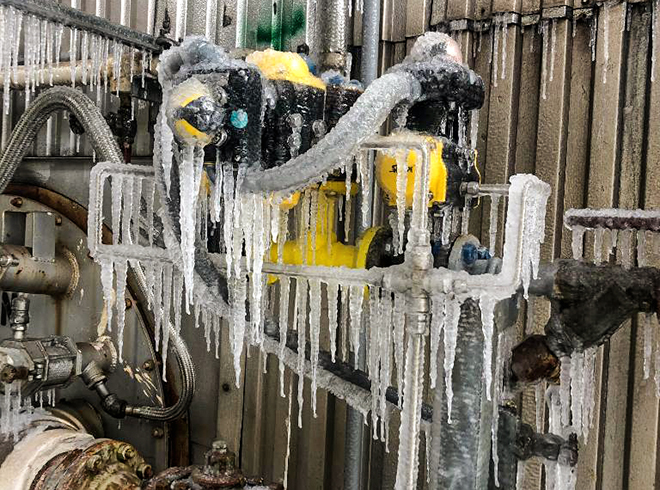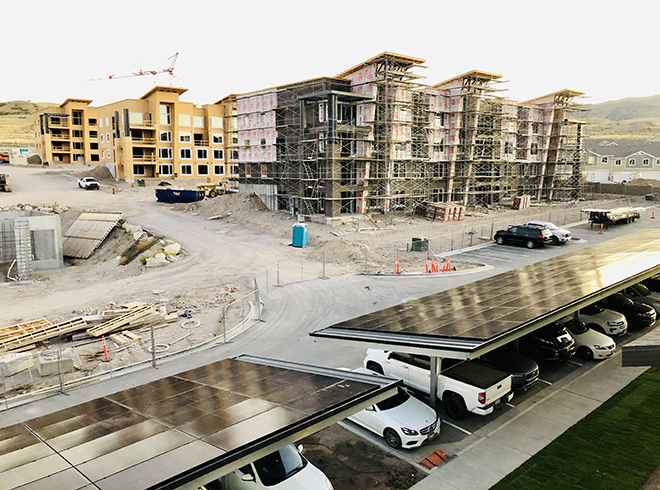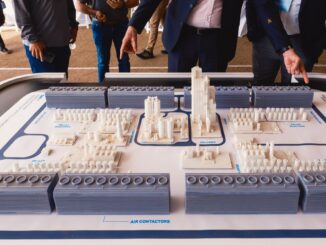
With concerns growing about the reliability of the electric grid, investors are increasingly focused on technologies that can help tie together distributed energy resources like this rooftop solar array at an Amazon facility.
Two weeks after a winter storm nearly took down Texas’ power grid in February, a software company called Uplight Inc. that promises to make the U.S. energy system more resilient vaulted to unicorn status with a new round of funding valuing the firm at $1.5 billion.
Power crises like the February outages that left millions of Texans freezing in the dark for days and the 2020 rolling blackouts in the western U.S. caused by extreme heat and wildfires have sparked demand for on-site energy systems like solar panels and batteries. But as the Uplight fundraising indicates, it is also accelerating investor interest in startups offering grid management platforms for a world where intermittent renewable resources, distributed solar and storage occupy larger portions of the generation mix.
It is an increasingly urgent challenge as the U.S. looks for ways to slash carbon-dioxide emissions and electrify large swaths of the economy while more extreme weather events strain aging infrastructure.
“The gap really has been, how do you use data and [Software-as-a-Service] to cohesively knit all those things together and kind of organize and rationalize how they’re deployed and used and managed,” said Steve McBee, CEO of Huck Capital Management LLC, which led a group of private-equity investors who participated in Uplight’s recent fundraising.
“When you think about the proliferation of batteries and solar and the extent to which they’re going to be relied upon to carry more of the load going forward and also to manage against volatile weather, you’ve got to have software and technology that balances it all,” said McBee, the former CEO of NRG Home, a subsidiary of NRG Energy Inc. “Changing the way energy is delivered and consumed … is not only a great money-making opportunity, but it’s got to happen for the health of the planet.”
Other investors are hunting similar opportunities. In the span of several weeks in late 2020 and early 2021, investors committed more than $1 billion for software-controlled clusters of rooftop solar systems, batteries, electric vehicles and other distributed energy devices.
The latest entrant to the space, a special purpose acquisition company called Beard Energy Transition Acquisition Corp., on March 9 said it plans to raise $250 million in an initial public offering to fund the purchase of a company focused on “the integration of intermittent renewables and dispatchable energy transition infrastructure.”
“The rapid growth of renewable power development … is complicating the electrical power grid,” the SPAC, which is led by Gregory Beard, a former senior partner at private equity company Apollo Global Capital Inc., said in a filing to the U.S. SEC. “We expect digital and infrastructure opportunities such as intelligent software, behind the grid solutions and battery storage will play key roles in addressing the increasing transmission and distribution complexity.”
Climate change is also testing the U.S. power system, posing risks to the grid that “can potentially affect the nation’s economic and national security,” the U.S. Government Accountability Office said in a report to Congress released March 10.
“[Power] disruptions during extreme weather events illustrate the need to plan for climate change risk and invest in climate resilience,” the GAO said.

| An Entergy Texas gas plant is shown covered in ice during a rare Arctic storm that knocked out power for millions of people across the state. Source: Entergy Texas |
Fueling transition
While Texas’ grid operator was still struggling to restore service to millions of people, John Berger, CEO of Houston-based residential solar company Sunnova Energy International Inc., on Feb. 16 predicted distributed generation will “grow like a weed” in the state after the worst blackouts there in decades.
“The only way that you can solve this problem … is put the generation next to the load, put it on your house,” Berger said in an interview after ice and freezing temperatures crippled power plants in Texas and nearly collapsed the state’s electric grid. “It’s really basic. It’s there, it’s going to work.”
Other executives have offered similar assessments.
George Sakellaris, chairman, president and CEO of energy services company Ameresco Inc., said on a March 1 earnings call that distributed power systems “will probably be the driving force behind having a reliable energy resource in the future.”
“In terms of where can money be invested to prevent either in Texas or elsewhere this happening again, I think it’s … directionally correct [that] more solar is probably a good part of the solution,” said Glenn Jacobson, a partner at Trilantic North America, a private equity firm with holdings in solar project developer Intersect Power Inc. and in the oil and gas sector. “There’s no reason why there shouldn’t be a large increase in the penetration of batteries in Texas and, in my mind, also of solar.”
Weather-driven volatility is creating “enormous tailwinds” for things like microgrids, backup power and batteries, said Shayle Kann, a partner at the investment firm Energy Impact Partners LLC. “I do think that it is still true that there’s a lot of opportunity for further innovation in the sort of grid-technology world, though I think we do have solutions that are deployable at scale today for a lot of these problems.”
Uplight, for example, which is backed by France’s Schneider Electric SE and U.S. power company AES Corp. and works with more than 80 energy providers, is developing software that “connects the dots” between electric vehicles, renewables, batteries and other internet-connected devices, company CEO Adrian Tuck said in a statement. At $1.5 billion, Uplight’s valuation is higher than the market capitalization of battery company Eos Energy Enterprises Inc., which went public through a SPAC merger in 2020.
Software, McBee said, is the “fuel driving the energy transition.”

| The Wasatch Group’s Soleil Lofts apartment complex in Herriman, Utah, were built to include solar panels, batteries, electric vehicle chargers and energy efficiency features.
Source: S&P Global Market Intelligence |
‘So much more complex’
But big challenges remain, especially as the industry prepares for an expected surge in power demand from electric vehicles.
“The software exists” to manage an evolving energy system, Jacobson said. “A bigger issue is market incentives” needed to spur the kinds of demand-response programs that can help adjust electricity demand to conditions on the grid.
“We’re really at the early stages of getting opt in from consumers on that,” Jacobson added. “There’s a massive investment opportunity somewhere around demand response.”
A critical question is how utilities, which can be conservative and slow-moving, will respond in the face of rapid change and increasing volatility.
“I go to a fair number of power conferences in the U.S., and you have leading utilities up there talking about the complexity of managing these integrated systems and the centrality of that process to their future effectiveness. So clearly the thinking is there,” said Ken Locklin, a director at Impax Asset Management LLC. “But if you’re in the coffee room afterward and you listen to some of the people from the smaller utilities, they’re not sure they understand exactly what’s going on or if they want to have anything to do with it, because it’s so different from the models that they’ve run. It’s so much more complex.”
Susan Flanagan, president and CEO of GE Energy Financial Services, in an email said she expects utilities to make a “renewed push for grid investment and modernization … including potential industry-wide weatherization standards.”
“Utilities are more aware than anyone of what can happen if things really go wrong in the electricity system,” said Kann, whose investment firm is backed by utilities. “And so I don’t think it substantially changes what they focus their attention on.”
S&P Global



